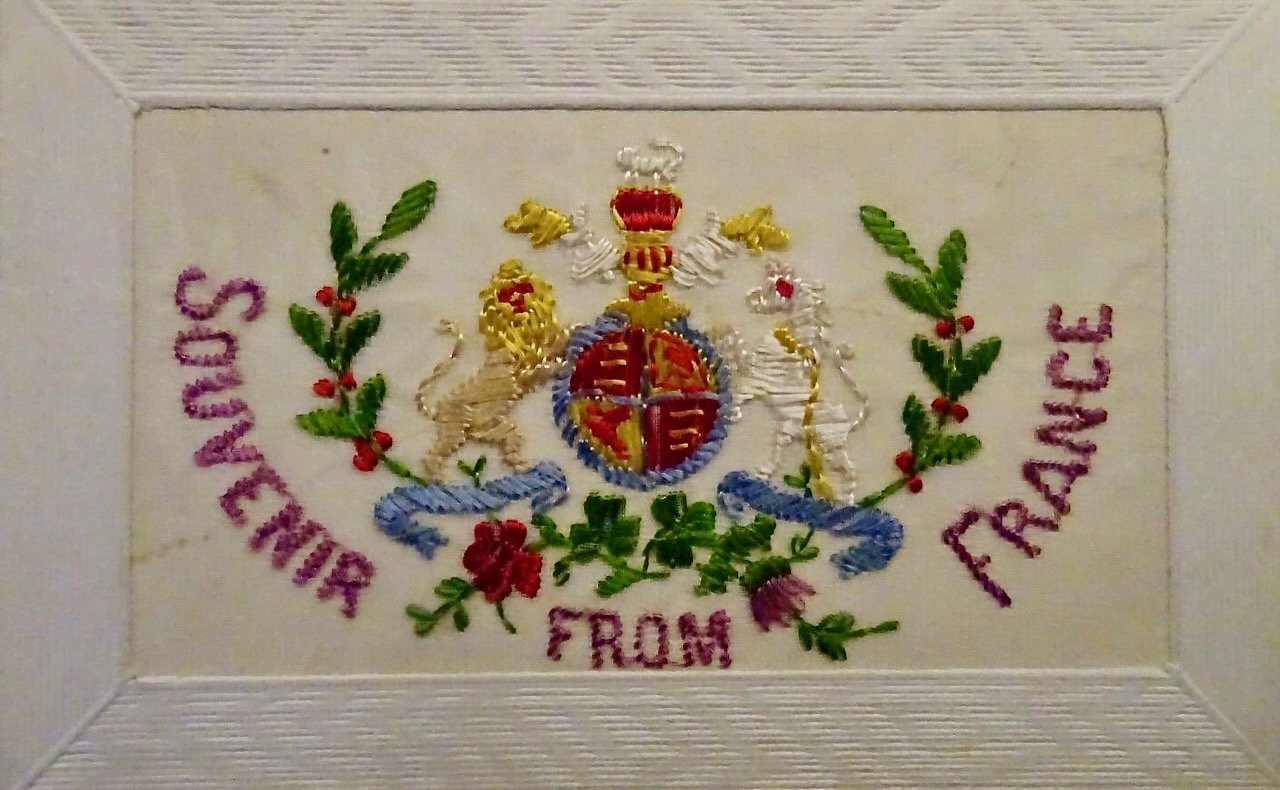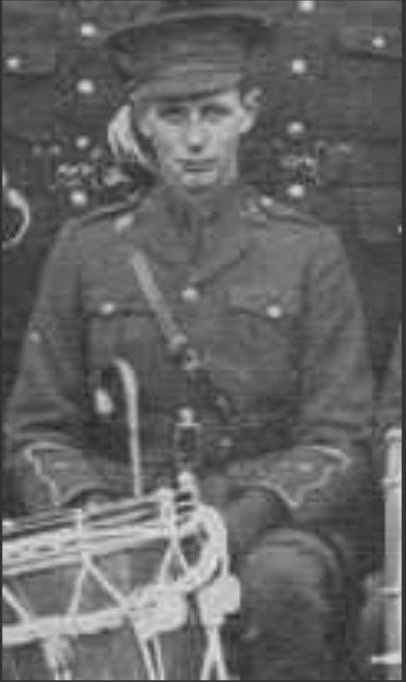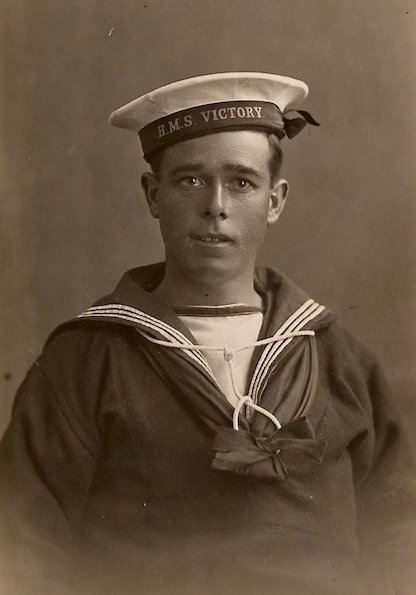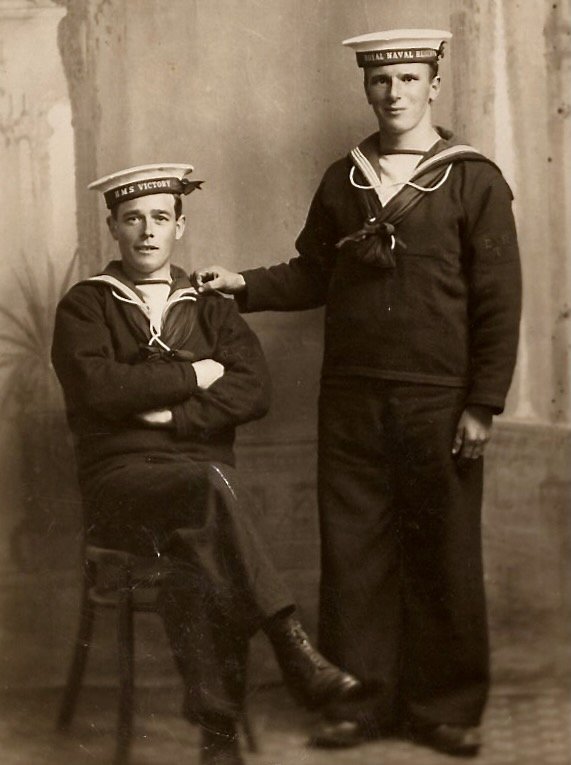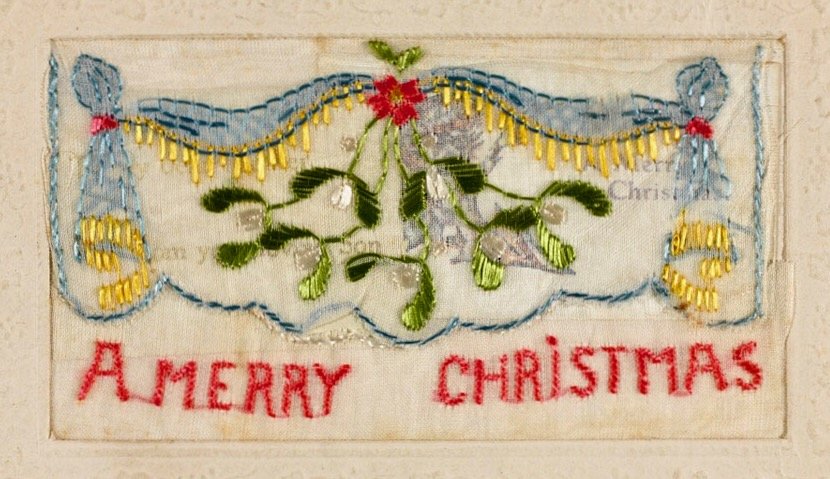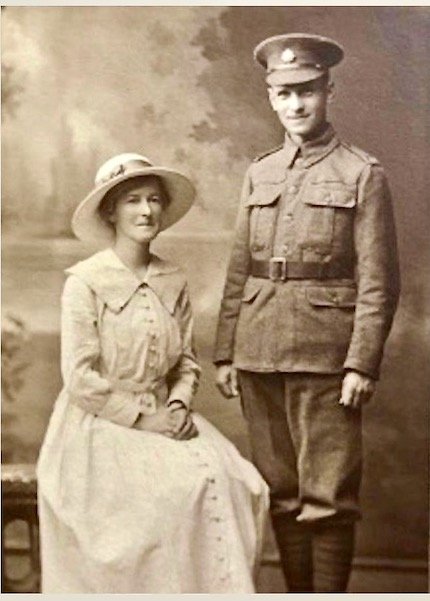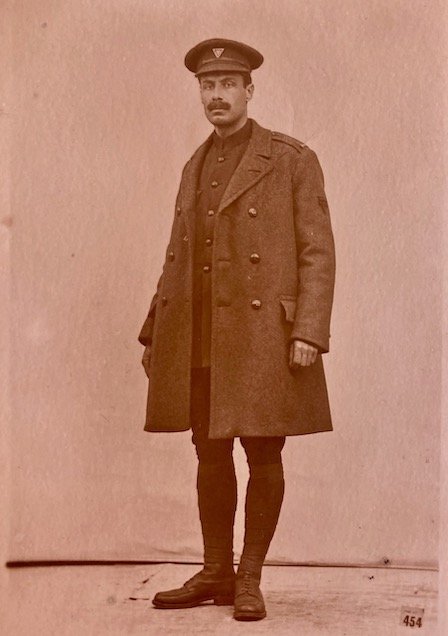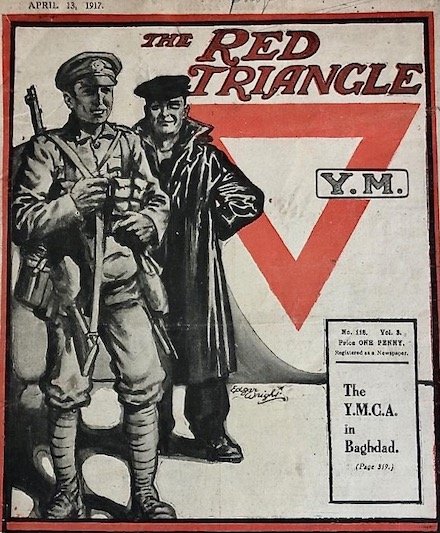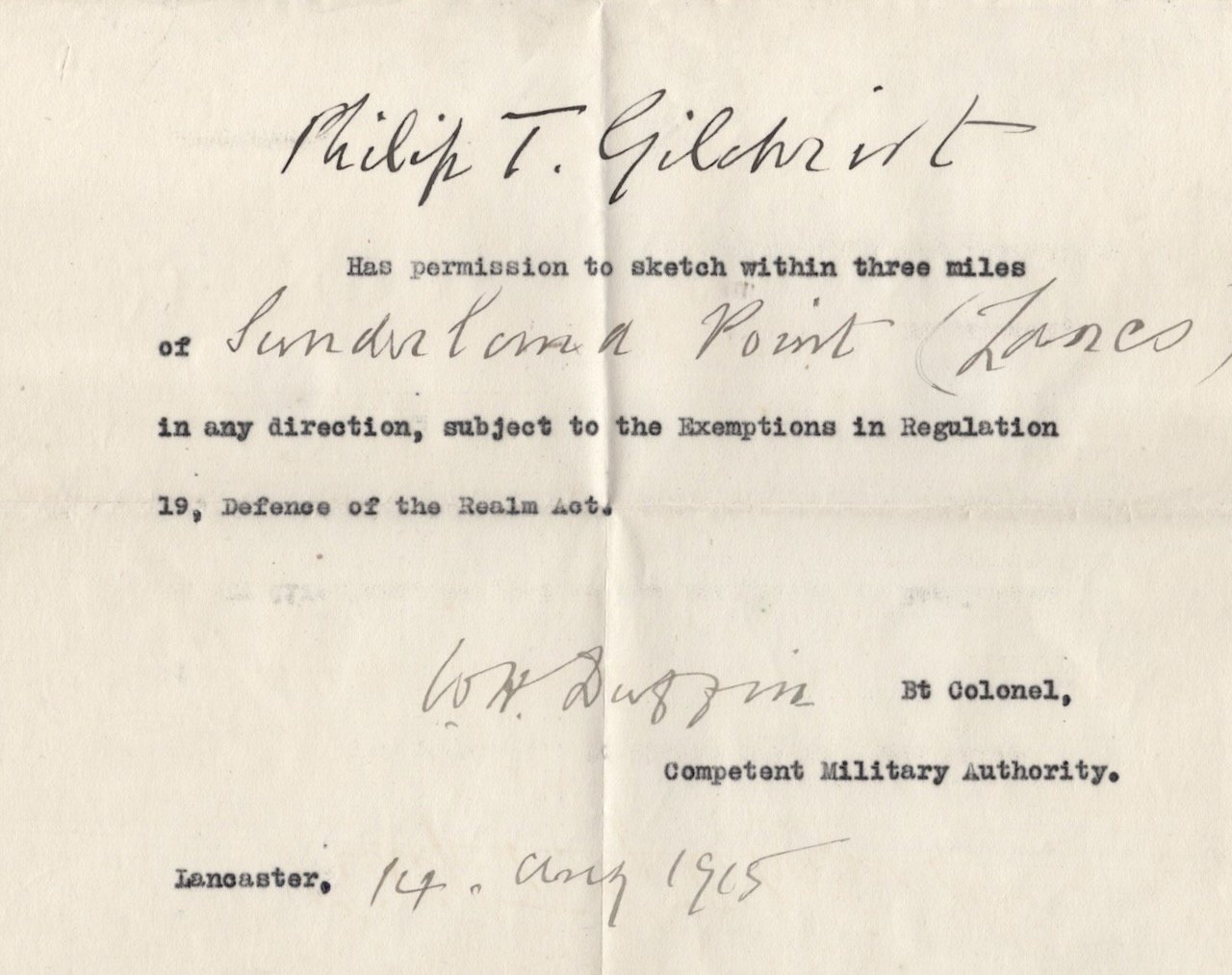World War One 1914-1918
Sincere thanks to the many who answered our request and contributed material on Sunderland Point during the war years. As so much has been received we have spilt the article, World War One this week and next weekend the Second World War.
There will be many individuals connected to the Point who served in the World Wars missed out as no records have been found in the time available – for that we apologise.
WW1 silk-thread woven postcard: Courtesy of the Imperial War Museum
The German military advance on France through neutral Belgium in August 1914 triggered the support treaty bringing Great Britain into the War. Whilst initially popular and attracting huge numbers of volunteers it rapidly degenerated into the bloody stalemate of trench warfare.
Conscription was introduced in 1916 to replace the thousands killed; women replaced the men at work and were drawn into service in hospitals and other military support. Most deaths occurred in battle caused largely by shellfire. By the time of the armistice in November 1918 just under 900,000 had been killed and over 1.6 million casualties from Great Britain.
The Point was affected by the war in a similar way, if much smaller, as were all other cities, towns and villages across the country.
Those lost.
Among those lost their lives was Henry Coupland who with his family had spent a number of summers at number 21. He was aged just 20 when killed at Ypres in Flanders in 1915.
Luke Gardner, born at number 20 (Cotton Tree Cottage) was a corporal in the Royal Field Artillery when he was also killed at Ypres but later in 1917. He was 27. Luke had moved with the family to Glasson Dock in 1899 but had returned Sunderland Brows Farm by 1911 to look after the horses.
Henry Coupland: Courtesy of the Imperial War Museum
Luke Gardner: Courtesy of Kris Needham
In 1916, George Townley, a nephew of William and Arnold Townley, was also killed.
Those who returned
Thomas Gardner: Courtesy of Kris Needham
Robert Forbes Mansergh: Courtesy of the Imperial War Museum
Luke’s older brother Thomas Gardner, also born at number 20, served as a sergeant with the Scots Guards and then with First Battalion Royal Lancaster Regiment ,promoted to Captain. After the war Thomas - known as ‘Captain Gardner or Gravelly Tom’ – returned to the Point and lived for many years at Gravelly.
The youngest Gardner brother, James, also born in Cotton Tree Cottage (after his father died), also enlisted and served in the Tank Corps. After the war he became a Police Constable and lived for the rest of his life in Lancaster.
During the war Luke and James visited their sister Maud in Lancaster. Her son George a boy of 6 in 1916 recorded memories of these visits.
‘But I’ll never forget too, the two brothers, Uncle Luke, and Uncle Jim, coming down Lune Street to see us. (Uncle Luke) was outside talking with my father, and he said “I don’t think I’ll be back again” - he had a feeling, he got leave from the Somme, and he knew how bad it was, and he didn’t come back. Uncle Jim was then in the Tank Corps, Uncle Luke, a mighty bloke, they were both in their early twenties, twenty-one or twenty-two, and I always admired my Uncle Luke, he looked so fine in his artillery uniform, puttees on his boots, shiny spurs, and he had this moustache - they all wore them, brown eyes, and brown hair, and he was the most beautiful drawer.’
Luke used to send drawings of horses to George in letters they exchanged.
In the photograph on the right above is Captain Robert Forbes Mansergh, the only son of Arthur H. Mansergh who lived at number 3. Robert was born in 1896 and appears to have been in the army from 1914 to 1920. He was wounded three times and in 1916 was awarded the Military Cross for ‘conspicuous gallantry in removing ammunition from a store which had been set on fire.’
Unrelated to Luke, Thomas, and James above, were the Gardner family living at number 9. By 1914 they had become one of the largest fishing and piloting families on the Point. Parents Richard and Ann came to the Point in 1887 firstly to Upsteps Cottage. As the family grew they moved to the “Cottage in the Fields’, 3A and then into ‘Large House’ number 9.
There were four sons and six daughters. Three of the four sons joined the armed forces.
Wilton Gardner: Courtesy of the Gardner family
Tom Gardner: Courtesy of Rosemary Lawn
On the left is Wilton Gardner with his wife Margaret and son Wilton in 1917. Married in 1906, Margret Annie was the daughter of James and Elizabeth Bowker who farmed Point Farm (number 14) between 1890 and 1912.
Wilton was 32 when war broke out and joined as a private the Royal Welch Fusiliers, 8th Battalion. In a remarkable service record, Wilton was in the Dardanelles and Gallipoli campaign in 1915, in Mesopotamia in 1916, Baghdad 1917 and Mosul (modern day Iraq) in 1918. He was awarded the Victory Medal.
In an equally remarkable business career, Wilton rose from an errand boy at 5 shillings a week to become Managing Director of A. H. Mansergh Ltd in Lancaster.
Thomas Gardner, on the right was 30 when he entered the Navy and served on the minesweeper Mackenzie. A fisherman and pilot all his life, he was also captain of the yacht Sue for Arthur Mansergh. He lived on the Lane at number 2 until his death in 1952.
Robert Gardner: Courtesy of the Gardner family
Mary Ann Gardner: Courtesy of the Gardner Family
On the left is Robert Gardner, youngest of the four sons, who was born in Upsteps cottage. In the early part of the War, he was working in a ship's broking business in Lancaster, helping ensure cargoes could reach their destinations. He enlisted into the Royal Marines in early 1917 and saw service in Mesopotamia in the Middle East, serving until 1919. After building a successful shipping and building materials businesses he spent the last years of his life at the Anchorage.
Mary Ann Gardner, on the right aged just 20 in 1914 appears to have served as a Red Cross nurse. In 1957 Mary came back to the Point and lived in the Summer House until her death in 1982. She was known to all as Auntie Polly.
Robert Gardner and Gertrude ‘Gertie’ Shenton in 1916. They were married in 1919: Courtesy of the Gardner family
Emily Edith Gardner: Courtesy of the Gardner family
Charlie Walker: Courtesy of the Gardner family
In these two photos, Emily, born in 1898 was the youngest of the ten Gardner children and trained as a nurse. On the right is Charlie Walker who also served in the army. They were married in 1924 and in 1945 came to live at the Point in number 3 the Lane bought from James Spencer for £700.
Both were tireless supporters of the village - for many years Charlie organised the egg rolling and races at Easter.
Although not directly involved in the war, eldest brother James W. Gardner skippered the aptly named boat ‘Depositor’ owned by his brother Robert. They had taken on a hazardous Government contract to dispose redundant WW1 ammunition dumped out at sea.
From the other large fishing family were the sons of William and Bessie Townley living at number 6. In 1917 Hubert, and a few months later Arnold, were both conscripted into the Royal Navy Reserve, Hubert was 25, Arnold had only just reached 18. Both returned home in 1919.
Hubert Townley: Courtesy of Rosemary Lawn
Arnold Townley: Courtesy of Rosemary Lawn
Both Hubert and Arnold were born at Sunderland Point in number 6 and were fishermen all their lives. Hubert married Clara Laud in 1930 and lived at number 4 the Lane - which for many years was also the Post Office. They later transferred into number 6. Sister Phoebe lived next door in the Little House, number 5. Arnold married Jessie Cuthill and moved into number 16 on Second Terrace where his uncle Arnold Townley had once lived. Both of his daughters Dorothy and Iris have contributed to this article.
Hubert Townley and Thomas Gardner were conscripted at similar times, and we have them in this photograph together, perhaps it’s just a keepsake for their close families.
Tom Gardner (sitting) with Hubert Townley: Courtesy of Rosemary Lawn
Their families were formally joined together in 1920 when Tom Gardner, returning from the war married Clarice Townley elder sister to Hubert and Arnold.
Clarice Townley and Thomas Gardner 1920: Courtesy of Rosemary Lawn
A silk-thread card handmade by a British Soldier in 1917: Courtesy The National Army Museum.
In the next two photographs we see (on the left) Alfred White and his wife (and cousin) Theodora nee Gilchrist. On the right is the Revd. William G. Swainson a grandson of Thomas Swainson who first came to the Point in 1872.
Jessie Theodora (known as Theo) and Alfred White: Courtesy of the Gilchrist family
Revd. William G. Swainson: Courtesy of the Gilchrist family
Alfred was 36 in 1914. He enlisted as a private in the Dragoon Guards, a mounted infantry division, and remained in the army until the end of the war. He was awarded the Victory Medal and the British War Medal.
In 1919, he was discharged into a convalescent medical unit. It is thought that Alfred, like so many others suffered great hardship from ‘shellshock’ and was unable to return to work as a bank clerk. Alfred and Theo bought the Moorings (number 3) later that year where they lived quietly until his death in 1951. Each spring there are attractive displays of daffodils at the Moorings, but mostly at Dolphin House (the home of home of his brother-in-law Philip Gilchrist), bred and planted by Alfred.
William and Dora Swainson: Courtesy of the Gilchrist family
Newspaper of the YMCA: Courtesy of the Gilchrist family
William Swainson will have known Sunderland Point since early childhood holidays. The left photograph is from his wedding in 1908 to Dora Gilchrist, a sister to Theodora above. He was 36 in 1914 and the vicar at Rainhill in Liverpool. As well as pastoral work in hospitals and with families deeply affected by the war, he volunteered into the YMCA (Young Mens Christian Association).
At the outbreak of war, the YMCA was the largest voluntary support organisation to the British forces in Britain and France and later across central and eastern Europe.
Throughout the war more than 40,000 volunteered to support the YMCA as they provided canteens, chapels, concert halls, libraries, and games rooms in hundreds of service camps. Importantly, over £7 million was raised to provide notepaper for over 200 million letters sent home. The red triangle, seen in the photo to the right was the welcome signal to servicemen in battlefields for a place of rest and simple recreation.
After military training in 1915 in London, William was posted overseas to the large, allied army base (over 500,000 troops), in Salonica Greece for seven months in 1917.
In 1946, he and Dora returned to the Point into number 21. In 1956 they transferred to Dolphin House where he lived until his death in 1964.
A number of villagers were tasked with looking out for suspicious activity on the river, one of these was Philip T. Gilchrist.
He also volunteered to provide quite different support.
Philip T Gilchrist in 1917: Courtesy of the Gilchrist family
In this last and moving photo from WW1, taken in April 1917, Philip is in the boathouse at Dolphin House manufacturing crutches. An estimated 41,000 servicemen lost limbs during the war. For the following half century, it was a common sight in the streets of Britain to see disabled veterans of the First World War.
On a lighter note, Philip was also a distinguished artist who was required to apply to the military to make sketches in the locality – here is his authorised pass.
Courtesy of the Gilchrist family
Philip and his family holidayed at the Point during his childhood and as an adult he lived here for over 50 years in number 14 and Dolphin House.
In the autumn of 1918, the German war effort finally collapsed and they were brought to an armistice on November 11th. The final peace treaty was signed in Versailles the following year.
The full list of credits will be published next week at the end of part two which covers the impact of the Second World War.
